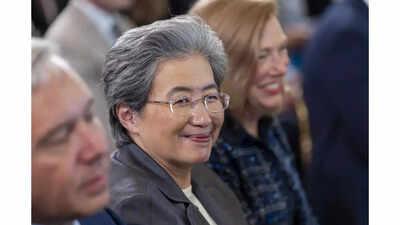ARTICLE AD BOX

In 2023, a Wall Street analyst summed up the AI hardware boom with a single brutal metaphor: “There’s a war going on out there in A.I., and Nvidia is the only arms dealer.” But what happens when the arms dealer’s own blood comes for the throne? Lisa Su — the soft-spoken engineer who once took apart a broken toy car just to see how it worked — has spent a decade quietly turning AMD into the most formidable challenger Jensen Huang has ever faced.
And in a twist straight out of a corporate soap opera, the woman threatening Nvidia’s empire isn’t a rival from Silicon Valley’s usual suspects. She’s Huang’s distant cousin.
The Big Picture
For two decades, Nvidia has been the undisputed king of graphics processors and the brains behind artificial intelligence. But AMD, under Lisa Su’s leadership since 2014, is now poised to become a genuine alternative — and perhaps the only company with the scale, technical depth, and strategic patience to challenge Nvidia’s supremacy.
1. From near-bankruptcy to $348 billion powerhouse
When Su took over AMD, the company was barely worth $3 billion and had lost almost all relevance in data centres. Intel ruled CPUs, Nvidia ruled GPUs, and AMD was seen as an also-ran. In a decade, she’s flipped that narrative: AMD’s market value has soared to $348 billion, its data-centre CPU share has climbed to 41%, and its chips power everything from PlayStation and Xbox consoles to cutting-edge cloud servers.Her formula was old-school Silicon Valley: focus on engineering, stay lean, and build for performance rather than chasing volume.
While Intel was sinking billions into fabs, Su doubled down on chip design — cramming billions of transistors into tiny silicon wafers and betting early on high-performance computing.
2. A megadeal that puts AMD squarely in Nvidia’s crosshairs
The real breakthrough came this week: OpenAI inked a deal to buy 6 gigawatts worth of AMD’s AI chips, a contract worth tens of billions of dollars and a direct challenge to Nvidia’s market dominance. The agreement also gives OpenAI up to 160 million AMD shares if performance milestones are met — a controversial move that Huang publicly mocked but one that cements AMD’s seat at the AI top table.The result: AMD’s stock price surged more than 33% in a week. The message from Wall Street was clear — Nvidia finally has a rival worth worrying about.
3. The engineer’s engineer vs. the showman
Su’s approach to leadership contrasts sharply with Huang’s. He built Nvidia into a juggernaut not just with cutting-edge hardware but also with CUDA, a proprietary software ecosystem that locks developers into Nvidia chips. AMD, by contrast, has struggled with software — even receiving public criticism from analysts for buggy platforms.But instead of ignoring it, Su called one critic personally, spent 90 minutes dissecting his arguments, and thanked him publicly: “Feedback is a gift.” That humility and technical rigour have become her calling card.
4. A family rivalry with geopolitical stakes
Born in Taiwan and raised in Queens, Su is the daughter of a mathematician and an accountant — and a distant relative of Huang. But their rivalry is no family drama; it’s a strategic contest that now has global implications.Nvidia controls over 75% of the AI data-centre GPU market, and its chips power the models that are transforming industries. But governments, hyperscalers, and AI labs increasingly want alternatives to avoid a single-vendor chokehold. Su is building precisely that — a second source of high-end AI silicon for the age of generative intelligence.
5. The road ahead
AMD still trails Nvidia in both market share and ecosystem depth. CUDA’s dominance, Nvidia’s early lead, and the sheer inertia of developer loyalty are formidable obstacles.
But with the MI300 GPU series, a pipeline of next-gen AI hardware, and partnerships like the one with OpenAI, AMD is no longer the underdog — it’s the contender.As Forrest Norrod, Su’s first hire and head of data-centre products, put it: “Before Lisa, AMD was chasing the mainstream. Now we’re chasing the performance crown.” And in AI, performance isn’t just about chips — it’s about who shapes the future of computing itself.Bottom line: The AI race is no longer a solo sprint. Huang may have defined the era of AI hardware, but Su is quietly rewriting the next chapter — one transistor at a time.

 7 hours ago
3
7 hours ago
3









 English (US) ·
English (US) ·